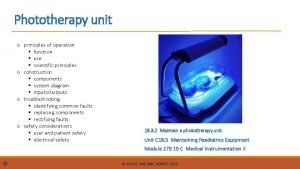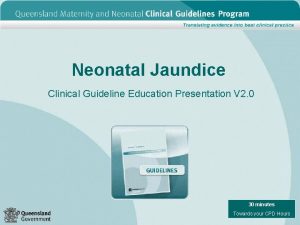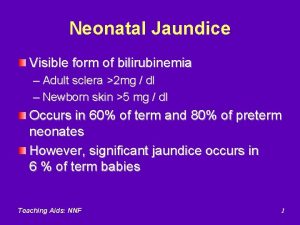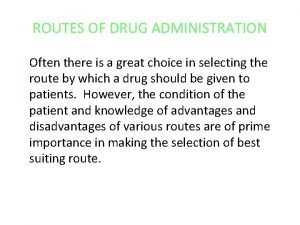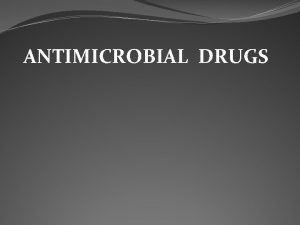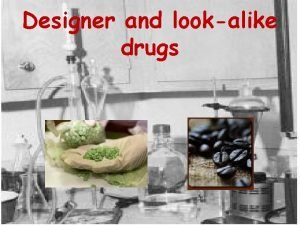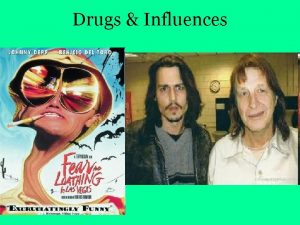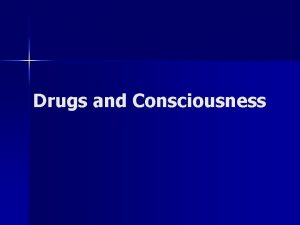Phototherapy and Photosensitising Drugs Different issues with different







![UVA (either broadband UVA [PUVA cubicle without psoralens] or UVA 1) Drug induced phototoxicity UVA (either broadband UVA [PUVA cubicle without psoralens] or UVA 1) Drug induced phototoxicity](https://slidetodoc.com/presentation_image/08581a716446281bbb27fd9d25d02a57/image-8.jpg)

- Slides: 9

Phototherapy and Photosensitising Drugs

Different issues with different phototherapies How long the drug is to be taken for and when during, or before, phototherapy it is started is key when deciding if any action needed There are many ways a drug can cause skin photosensitivity Sunburn-like phototoxicity is most common Phototoxicity is dose related (e. g. , 200 mg daily doxycycline frequently photosensitises to UVA in fair-skinned people but usually 100 mg daily doxycycline does not do so) Even when the mechanism is phototoxicity not everone will react even with a high dose – often drug metabolites are the main problem and our metabolising systems differ)


Narrowband ultraviolet B Most photosensitising drugs are not an issue as ultraviolet A (UVA) is much more likely to cause problems with most drugs. There are some exceptions (see new Photonet guidance on drugs that might be a problem and commonly started drugs that are not a problem). If drug precedes phototherapy then starting with minimal erythema dose assessment or other small area test befor whole-body treatment is all that is needed. If a potentially problematic drug is for a short course often best to temporarily stop UVB. If started during phototherapy course and a long course is planned an individual plan must be made (What drug? What drug dose? How far into UVB course and dose reached compared with baseline MED if checked? )

Photosensitizing drugs may lower the narrow‐band ultraviolet B (TL‐ 01) minimal erythema dose Cameron H & Dawe RS. British Journal of Dermatology, Volume: 142, Issue: 2, Pages: 389 -390, First published: 24 December 2001, DOI: (10. 1046/j. 1365 -2133. 2000. 03325. x) NSAIDs, phenothiazines and calcium channel blockers associated with lower pre-treatment narrowband UVB MEDs

Are photosensitizing medications associated with increased risk of important erythemal reactions during ultraviolet B phototherapy? Harrop G et al. British Journal of Dermatology, Volume: 179, Issue: 5, Pages: 1184 -1185, First published: 19 May 2018, DOI: (10. 1111/bjd. 16800) Potentially phototoxic drugs associated with (might not cause) more important erythema episodes during UVB courses.

PUVA Not normally an issue as psoralens are usually so much more photosensitising so addition of another phototoxic drug is rarely relevant. For example, an individual’s minimal erythema dose with UVA might be 30 J/cm² but their minimal phototoxic dose with PUVA might be 0. 5 J/cm² (so a phototoxic index of 60) whereas another highly UVA photosensitising drug such as ciprofloxacin might still only have a phototoxic index of 3. If MPDs are not done, caution is needed with any new UVA sensitising drugs in case the patient is effectively just getting UVA (not “proper” PUVA). In general, it is best to be cautious with short (e. g. antibiotic) courses and temporarily with-hold PUVA.
![UVA either broadband UVA PUVA cubicle without psoralens or UVA 1 Drug induced phototoxicity UVA (either broadband UVA [PUVA cubicle without psoralens] or UVA 1) Drug induced phototoxicity](https://slidetodoc.com/presentation_image/08581a716446281bbb27fd9d25d02a57/image-8.jpg)
UVA (either broadband UVA [PUVA cubicle without psoralens] or UVA 1) Drug induced phototoxicity more of a concern, but these treatments not widely used – best to seek individual advice from referring clinicisn if unsure.

Summary See guidance on or soon to be on Photonet website. In most situations the main risk of potentially photosensitising drugs is that effective phototherapy might be compromised by excessive caution.

